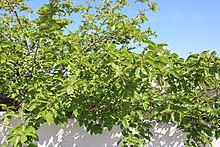
Back Witmoerbei Afrikaans Morus alba AN توت أبيض Arabic توت ابيض ARZ নুনী Assamese Ağ tut Azerbaijani آغ توت AZB Шаўкоўніца белая Byelorussian Бяла черница Bulgarian সাদা তুঁত Bengali/Bangla
| White mulberry | |
|---|---|

| |
| Scientific classification | |
| Kingdom: | Plantae |
| Clade: | Tracheophytes |
| Clade: | Angiosperms |
| Clade: | Eudicots |
| Clade: | Rosids |
| Order: | Rosales |
| Family: | Moraceae |
| Genus: | Morus |
| Species: | M. alba
|
| Binomial name | |
| Morus alba L. 1753
| |
| Subspecies | |
| |
| Synonyms[1] | |
| |
Morus alba, known as white mulberry, common mulberry and silkworm mulberry,[2] is a fast-growing, small to medium-sized mulberry tree which grows to 10–20 m (33–66 ft) tall. It is native to China and India and is widely cultivated and naturalized elsewhere.
The white mulberry is widely cultivated to feed the silkworms employed in the commercial production of silk. It is also notable for the rapid release of its pollen, which is launched at greater than half the speed of sound. Its berries are edible when ripe.
- ^ "Morus alba L.". World Checklist of Selected Plant Families. Royal Botanic Gardens, Kew – via The Plant List. Note that this website has been superseded by World Flora Online
- ^ Morus alba L. by Weeds of Australia - Biosecurity Queensland Edition (Queensland Government)